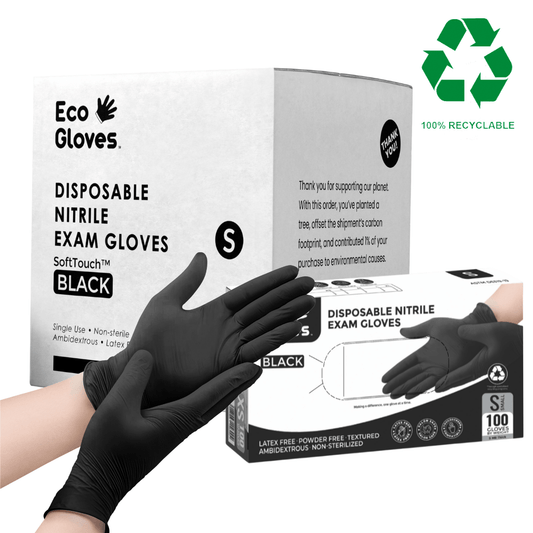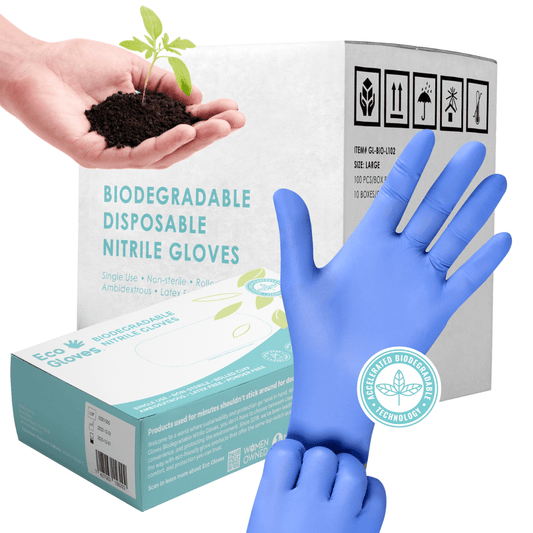Black Nitrile Gloves: The Complete Buyer’s Guide (Sizes, Thickness, Uses)
Eco Gloves
Whether you’re a tattoo artist, esthetician, mechanic, cleaner, or running a foodservice line, choosing the right disposable glove affects safety, comfort, and efficiency on every shift. This guide breaks down nitrile gloves in plain language, how they’re made, what “mil” thickness really means, how to size them correctly, and where they shine in real-world tasks. You’ll also see how they compare with latex and vinyl, what to consider when buying in bulk, and the latest options for lower-impact, more sustainable choices. Use this as a practical reference to pick the right glove for your team and the job at hand.
Table of Contents
- What Are Black Nitrile Gloves and Why Color Matters
- What Glove Thickness Means for Strength and Sensitivity
- Finding the Right Glove Size and Fit
- Industry-Specific Uses for Black Gloves
- Black Nitrile vs. Latex vs. Vinyl: How They Compare
- Buying Black Nitrile Gloves in Bulk
- Environmental & Sustainable Glove Options
- How to Pick Disposable Gloves: A Step-by-Step Guide
- Conclusion
- Key Takeaways
-
Frequently Asked Questions (FAQs)
What Are Black Nitrile Gloves, and Why Color Matters
Black nitrile gloves are single-use, latex-free gloves made from NBR (nitrile butadiene rubber). They offer a practical mix of barrier protection, oil/chemical resistance, and tactile sensitivity, which is why they’ve become the go-to across tattoo studios, beauty and esthetics, automotive shops, cleaning/janitorial teams, and foodservice. Compared with common blue or pink nitrile gloves, the “black” part is primarily about workflow and appearance: the dark color hides inks, dyes, grease, and stains for a professional look and can make tears or surface contamination easier to notice in contrast-sensitive environments (e.g., tattooing or cosmetic treatments). See “Industry-specific uses” below.
For regulated contexts, “exam” in black nitrile exam gloves refers to products that meet medical examination standards (for example, ASTM D6319 in the U.S.). This standard covers physical properties and performance criteria for nitrile examination gloves used in medical settings.
What Glove Thickness Means for Strength and Sensitivity
Glove “mil” is a unit of thickness equal to one-thousandth of an inch (1 mil = 0.001 in). That’s not marketing jargon; it’s the engineering unit you’ll also see in coatings, films, and packaging.
Nitrile Glove Thickness Guide
| Thickness | Description | Ideal Use |
|---|---|---|
| 3–4 mil | Lightweight, form-fitting nitrile gloves that maximize dexterity and tactile feedback. | Food prep, beauty services, and light cleaning tasks where frequent glove changes are expected. |
| 5 mil | A balanced “daily-driver” thickness offering good puncture resistance without feeling bulky. | Tattoo, esthetics, and janitorial applications requiring consistent comfort and durability. |
| 6+ mil | Extra-thick black nitrile gloves built for tougher jobs, providing superior tear and abrasion resistance. | Automotive, mechanical, maintenance, and heavy-duty work involving oils, solvents, or rough materials. |
Finding the Right Glove Size and Fit
A proper fit reduces hand fatigue, improves precision, and lowers the risk of tears when donning/doffing. Most black nitrile gloves come in XS–XL (sometimes up to XXL).

Industry-Specific Uses
1. Tattoo Artists & Estheticians (Professional Aesthetic and Practical Advantages)
In studios and treatment rooms, black nitrile gloves keep the visual field clean by masking ink, pigment, and small amounts of blood or fluids, which supports a professional appearance during client-facing procedures. Artists and estheticians also favor the contrast of black against lighter tools and skin, which can aid visual focus during detailed work.
- Recommended thickness: 4–6 mil for sessions that involve needles or abrasive contact with equipment.
- Finish/texture: Micro-textured fingertips improve grip on cartridges, tweezers, and bottles without losing fine control.
💡Pro tip: Choose black nitrile exam gloves if you want a product aligned with recognized exam-grade performance criteria (ASTM D6319).
2. Automotive & Mechanics (Oil/Chemical Resistance)
NBR’s acrylonitrile component gives nitrile gloves superior resistance to oils, greases, and many petroleum-based substances compared with latex or vinyl. That’s why detailers, mechanics, and DIYers reach for thick black nitrile gloves when handling motor oil, lubricants, adhesives, or diesel. Research and industry guidance consistently note nitrile’s favorable oil and many-chemical resistance profile.
- Recommended thickness: 5–6 mil.
- Texture: Heavier texturing helps retain grip on oily parts and tools.
Important: Always consult the glove’s chemical permeation data for your specific solvents. Movement, exposure time, and temperature all matter.
3. Cleaning & Janitorial (Puncture/Tear Resistance and Frequent Changes)
For housekeeping, facilities, and janitorial teams, black nitrile gloves offer strong puncture/tear resistance for routine tasks like bathroom turnover, quick disinfecting, and trash handling. Because these roles involve frequent glove changes, a balanced weight (4–5 mil) often makes sense, durable enough for wipes and sprayers, thin enough for easy donning between rooms. Reviews and occupational hygiene literature underscore how product formulations differ; not all “5 mil” feel the same, so choose reputable exam- or industrial-grade lines and trial them with real workflows.
4. Foodservice & Hospitality (Sanitary Appearance with Proper Handling)
Many food codes in the U.S. recommend suitable single-use gloves (including nitrile gloves) when handling ready-to-eat items, with strict rules that gloves be used for only one task and discarded when contaminated or interrupted. Black nitrile can present a clean, uniform appearance on the line, especially for front-of-house assembly or catering, provided staff follow hand-washing and changeout requirements.
❗Key reminders for kitchens:
- Gloves are single-use; change when switching tasks, after touching hair/face, after handling raw proteins, or when gloves are torn/soiled.
-
For medical-device claims (e.g., “exam”), the FDA’s Center for Devices regulates exam gloves; for food handling, the relevant oversight is the FDA’s Center for Food Safety and Applied Nutrition (CFSAN) and the Food Code adopted by your state.

Black Nitrile vs. Latex vs. Vinyl: How They Compare
Nitrile
Excellent resistance to oils, many chemicals, and punctures; latex-free (key for allergy-sensitive settings); typically higher tensile strength than vinyl at similar thicknesses.
Latex
Very elastic and tactile, but natural rubber proteins can trigger allergies or sensitization, especially among frequent users. Global prevalence estimates suggest ~9.7% among healthcare workers, ~7.2% among susceptible patients, and ~4.3% in the general population, which is why many facilities standardize on latex-free gloves.
Vinyl
Budget-friendly and anti-static, but generally less tear- and puncture-resistant and less form-fitting. Vinyl can be suitable for light, low-risk tasks with frequent glove changes, though many teams prefer nitrile gloves for durability.
Buying Black Nitrile Gloves in Bulk
If you change gloves often (in food lines, housekeeping, or salons) or outfit multiple stations, bulk purchasing of black nitrile gloves lowers the per-glove cost and stabilizes the supply. Before you buy cases:
1. Pilot test 2–3 thicknesses with your actual workflows.
2. Confirm box counts (typically 100 per box; some thicker gloves pack 90) and case counts for true cost comparisons.
3. Mix sizes based on staff hands (common splits are 10–15% S, 40–50% M, 30–35% L, 5–10% XL).
4. Check storage: cool, dry, away from sunlight and ozone (extends shelf life and integrity).
Environmental & Sustainable Glove Options
Sustainability has become a growing priority for glove buyers, driving innovation across materials and manufacturing practices. Today, you’ll find biodegradable nitrile gloves engineered to deliver the same fit, feel, and durability as conventional nitrile while offering improved end-of-life performance.
For lighter-duty applications where industrial strength isn’t required, plant-based and compostable gloves provide an eco-conscious alternative.
When purchasing, consider choosing gloves from environmentally responsible and ethically operated suppliers or manufacturers—those that demonstrate measurable commitments to carbon reduction, tree planting, and responsible production practices across their operations.
How to Pick Disposable Gloves: A Step-by-Step Guide
Selecting the right disposable glove doesn’t have to be complicated. A thoughtful approach ensures you get the best balance of protection, comfort, and value for your specific tasks.
- Define the Job: Identify how the gloves will be used—tattoo or PMU work, hair coloring, detailing, food prep, janitorial, or maintenance. The specific task determines the level of protection and dexterity you’ll need.
- Pick the Right Thickness: Start with 4–5 mil gloves for most applications. Move up to 6 mil or thicker if you’re experiencing tears or working with oils, chemicals, or abrasive materials.
- Decide on the Finish: Micro-textured gloves enhance fingertip sensitivity and control, while fully textured surfaces provide superior grip in wet or oily conditions.
- Confirm the Grade: Choose exam-grade black nitrile gloves for clinical, body-art, or esthetic settings that require tested performance. Select industrial-grade gloves for cleaning, detailing, and maintenance tasks.
- Check Sizing: Proper fit ensures comfort and safety. If ordering for a team, buy a mixed case of sizes to accommodate everyone.
- Choose Your Material Strategy: Go with standard nitrile gloves for durability and versatility, or explore biodegradable nitrile and plant-based options for a more sustainable choice.

Conclusion
If you need reliable black nitrile gloves, from lightweight food handling to thick black nitrile gloves for automotive, Eco Gloves offers a full range, including biodegradable nitrile and plant-based/compostable options, with a mission to reduce environmental impact across the disposable-glove lifecycle. Explore the latest collections, check sizes and mil ratings, and review company commitments on Sustainability before you buy in bulk. Learn more at https://ecogloves.co/.
Key Takeaways
- Color is functional. Black hides stains and looks professional in client-facing work, ideal for tattoo/PMU, hair color, detailing, and FOH food assembly.
- Match thickness to task. 3–4 mil for light duty; 5 mil nitrile gloves as an all-around choice; thick black nitrile gloves (6+ mil) for oily, abrasive jobs. Mil is a real engineering unit (0.001 in).
- Allergy and compliance matter. Nitrile is latex-free; latex sensitivity is well-documented among frequent users, which is why many teams standardize on nitrile.
- Gloves are single-use and task-specific under the FDA Food Code; color doesn’t replace proper hygiene.
- Nitrile resists oils and many chemicals, but movement and time change permeation; choose purpose-built gloves and replace them often.
-
Sustainability is expanding. Consider biodegradable nitrile and compostable gloves where they fit the task, and review a supplier’s Sustainability commitments
Frequently Asked Questions (FAQs)
Are black nitrile gloves thicker or stronger than blue nitrile gloves?
Color doesn’t dictate strength. Performance depends on formulation, thickness (mil), and manufacturing quality. A 5-mil nitrile glove product in black and a 5-mil product in blue can perform similarly if they’re built to the same standard. For medical-exam contexts, look for compliance with ASTM D6319.
Why do professionals prefer black gloves?
Black masks ink, pigment, dyes, and grime for a cleaner look during procedures and client interactions, useful in tattooing, PMU, hair color, and detailing. Some artists also find that dark gloves provide better visual contrast against equipment and skin.
Can black nitrile gloves be used for food handling?
Yes, provided you follow your local Food Code and best practices for glove use (single-task use, frequent changes, and proper handwashing). In the U.S., the FDA Food Code outlines when and how single-use gloves should be used in foodservice.
What does 5 mil or 6 mil mean in glove thickness?
“Mil” is one-thousandth of an inch (0.001 in). A 5-mil glove is ~0.005 inches thick at the measured area. Thicker gloves tend to improve tear/abrasion resistance but may reduce tactile feel. Always verify your task’s needs.
Are black nitrile gloves latex-free?
Yes. Nitrile is a synthetic rubber and contains no natural rubber latex proteins. This matters because latex allergy remains a real occupational issue; latex-free gloves help avoid sensitization and reactions.
Are nitrile gloves chemically resistant?
Generally yes, especially against oils, greases, and many hydrocarbons, one reason they’re favored in automotive and maintenance. But resistance varies by chemical, brand, and motion; consult permeation data and replace gloves often.
Do black nitrile exam gloves need FDA clearance?
In the U.S., medical exam gloves are regulated devices requiring a 510(k) premarket notification and must meet set performance criteria. Food-handling gloves are overseen under different guidance (CFSAN, Food Code).
Further Reading















